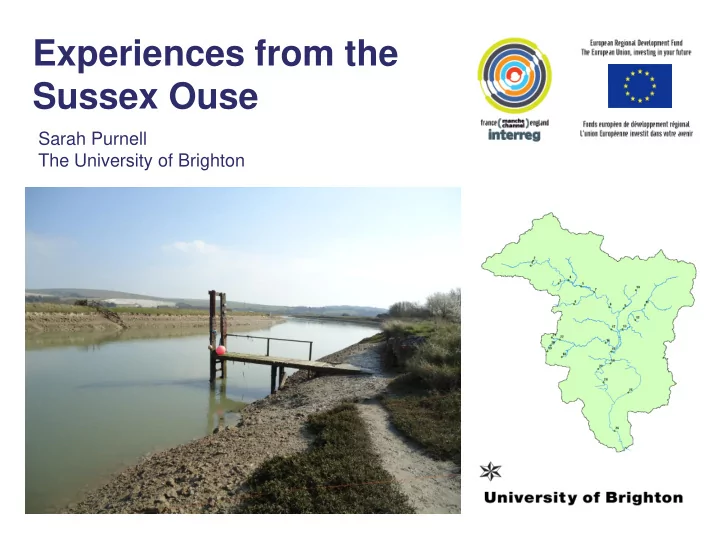

Experiences from the Sussex Ouse Sarah Purnell The University of Brighton
The University of Brighton partner: The Environment & Public Health Research Unit (EPHRU) has specialist facilities used for research into the microbial quality of fresh, estuarine, and marine (aquatic and terrestrial) environments. Active on the AquaManche project: Professor Huw Taylor Dr. James Ebdon Miss Sarah Purnell
The River Ouse 26 monthly Catchment, East sampling sites Sussex, UK • Approximately 605 km 2 • Predominantly rural (65% agriculture) • Main urban areas: Newhaven, Lewes, Uckfield and Haywards Heath
Monthly baseline sampling 32 visits (2009-2011), 853 samples analysed for: • Temperature ( o C) • Conductivity ( μ S) • Dissolved oxygen (mg/l) • pH • Redox potential (mV) • Turbidity (NTU)
Monitoring water quality: Bacterial indicators of faecal pollution Intestinal enterococci Faecal coliforms ( E.coli )
and viral indicators of faecal pollution (double-agar layer method) (Burbano-Rosero et al ., 2011) (Diston, 2010, da Silva, 2012) Somatic coliphage (general faecal GB124 (human-specific marker) indicator)
Mean faecal coliforms (Log10 CFU/100ml) Mean intestinal enterococci (Log10 CFU/100ml) 6.0 The EU Bathing Water Directive 5.5 excellent quality standard for inland bathing waters for both The EU Bathing Water Directive sufficient quality standard for inland bathing waters E.coli and intestinal enterococci 5.0 for both E.coli and intestinal enterococci 4.5 4.0 Mean CFU/100ml (Log10) 3.5 3.0 2.5 2.0 1.5 1.0 0.5 0.0 1 2 3 4 5 6 6b 7 8 9 10 11 12 13 14 15 16 17 18 19 20 21 22 23 24 25 26 Site Number
The map shows AquaManche water quality monitoring sites in the River Ouse catchment. The pie charts show the percentage of samples that failed to meet ‘sufficient’ water quality classification according to the EU Bathing Water Directive. Although these sites are not designated as bathing water sites, these results illustrate the level of faecal contamination present within the River Ouse catchment.
Human specific marker GB124 marker never detected at these sites, animal sources Somatic Coliphage may be dominant faecal contributors at these sites 7.0 Mean somatic coliphage (Log10 PFU/100ml) 6.0 5.0 4.0 3.0 2.0 1.0 0.0 1 2 3 4 5 6 6b 7 8 9 10 11 12 13 14 15 16 17 18 19 20 21 22 23 24 25 26 Site Number 6.0 Human specific marker GB124 Directly downstream of waste Mean GB124 phage (Log10 PFU/100ml) water treatment works 5.0 4.0 3.0 2.0 1.0 0.0 1 2 3 4 5 6 6b 7 8 9 10 11 12 13 14 15 16 17 18 19 20 21 22 23 24 25 26 Site Number
Correlation: Between chemo-physical and microbial parameters? No strong correlations were found between chemo-physical and microbial parameters for the whole data set. Interestingly, at tidal sites there were moderate to strong, significant relationships between faecal indicator organisms ( E.coli , intestinal enterococci, and somatic coliphage) and temperature, conductivity, turbidity and rainfall (previous 24h prior to sampling) ( p =<0.01). At non-tidal sites correlation with FIO and dissolved oxygen was more apparent ( p <0.01). Moderate correlations existed between faecal indicator bacteria and turbidity ( p =<0.01).
‘Spring’ and ‘neap’ tide data analysis: Spring There was significant correlation between rainfall and faecal indicator organisms and chemo-physical parameters such as turbidity (P=<0.01: R s =0.837). Neap
Modelling using the Soil and Water Assessment Tool (SWAT) SWAT is a river basin scale model developed to quantify the impact of land management practices in large, complex watersheds. Results of the model indicate a significant relationship between simulated and monitored concentrations of faecal indicator organisms (FIO).
Outputs and Conclusions The River Ouse currently receives high loads of faecal pollution in relation to current legislation. Bacteriophage of the human-specific marker GB124 were detected at all sampling sites with the exception of four, which appeared to be dominated by non-human faecal inputs. Detected concentrations of GB124 were low throughout much of the two year sampling period. Concentrations reached their highest levels after heavy rainfall. One storm event in particular resulted in GB124 levels in access of 85,000 PFU/100ml. These bacteriophages have been shown to be co-present with human adenovirus and norovirus so may offer an insight into the potential human health risk. The combination of monitoring, MST and modelling within the River Ouse catchment (as part of an ARMT) may offer risk prediction and inform future management within the catchment.
Future work in the Ouse Focus on developing the model to produce the optimum model of flow and microbial concentrations. Examine the potential of incorporating other modelling techniques. Assess the potential impacts of land use / climate change on water quality within the River Ouse catchment.
Acknowledgements This work was supported by the European Regional Development Fund Interreg IVA Programme as part of the collaborative project AquaManche. We would like to thank Morgane Bougeard for her help with SWAT training and our colleagues at IFREMER (Station Brest) for their support. We would also like to thank Southern Water, the Environment Agency, South East Water and the Met Office for supplying additional meteorological, flow, and flow discharge data.
University of Brighton AquaManche Publications: Ravenscroft, N., Church, A., Gilchrist, P., Watson, J. (2012). Reconfiguring lay knowledges: generating critical engagement with the science of diffuse riverine pollution. Paper in preparation. To be submitted to Land Use Policy . Nnane, D.E., Ebdon, J.E., and Taylor, H.D. (2012). The dynamics of faecal indicator organisms in a temporate river during storm conditions: evidence for the contribution of human and non-human sources. Journal of Water and Climate Change, 3 (2), 139-150. Purnell, S.E., Ebdon, J.E., and Taylor, H.D. (2011). Bacteriophage lysis of Enterococcus host strains: A tool for microbial source tracking? Environmental Science and Technology . 45 (24), pp 10699-10705. DOI: 10.1021/es202141x Nnane, D.E., Ebdon, J.E., and Taylor, H.D. (2011). Integrated analysis of water quality parameters for cost-effective faecal pollution management in river catchments. Water Research . 45, (6), 2235-2246.
Recommend
More recommend